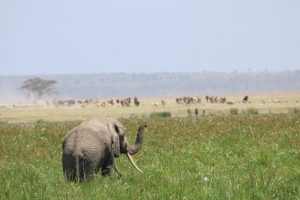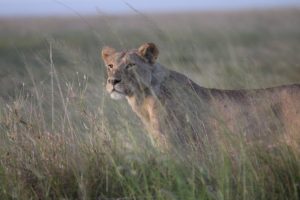Beyond the Data Points
Reflections by Kailey Carlson, undergraduate fellow with the CCC Fellows Project, Engaging the Collaborative Capital of Lion Guardians to Reduce Lost Livestock in Maasailands
Though we may try relentlessly, we can’t always quantify human and animal behavior into neat graphs and data curves.
I have spent many hours sifting through data sets, and importing GPS data related to human-wildlife conflicts and lost livestock instances into GIS software. In our last blog by Philip Briggs, he noted the intense rainfall of last season, and a major spike in lion-human conflict. With this lead, I hoped to find some correlation among conflict and rainfall within the years of data. After nearly two hours overlaying thousands of instances of lion-human conflict with each data point’s corresponding monthly rainfall data, I just stared at the graph. It was a straight horizontal line right through the page. Zero correlation among rainfall and instances of conflict, despite seeing trends of increased lion conflict with seasonality. I thought that maybe I had something, but apparently not.
This instance seemed to epitomize perhaps one of the most beautiful, and frustrating, components of dealing with these wicked problems in conservation. And this project, alongside Lion Guardians, never fails to recognize that.

Though data analysis and numbers could be important in illustrating what is going on in an area, it is also important to find the motives behind people’s actions, more than merely trying to quantify some behavior— that is the heart of this project. It’s working with people and their philosophies and long ingrained cultural perceptions of the land and the livestock and the wildlife.
Data points and graphs probably aren’t going to speak to herders who are watching their livelihoods, their cattle or sheep, getting lost in a shuffle only to be found days later as a carcass mauled by the harsh wildlife in the Amboseli ecosystem. Data points and graphs won’t change a culture that has thrived using particular practices for thousands of years, nor should it. In fact, it seems our Western ways of imposing our own practices on other cultures has gained little ground in a place that has thrived in harmony with its environment for so long, without exploiting and scathing the landscape for human benefit. Perhaps, as Westerners, if we approach such complex conservation problems with a background in humility, we might have a greater impact on more than just numbers, but people as well.

Data integration and analysis is important, but it certainly isn’t everything. Maybe some of our GIS data will allow us to identify hotspots and trends that could help us in understanding future change, and document the recovery of these lion populations. But humans and wildlife don’t necessarily operate according to our mathematical boxes and the curves we try to press them into. Surely research has allowed us to move past Descartes’ declaration that animals are automata, machines operating with no consciousness. Humans aren’t machines, nor are the wildlife we encounter. We need to recognize that, and the fact that a seemingly simple decision of an individual human (or lion) is subject to thousands of factors unique to that individual’s experience. It might put one at a standstill for what to do, but this recognition is one of the first ways of moving forward in conservation.
There is a particular beauty in the intricacies and complexities of our world. Our graphs may not solve complex challenges, but getting to the heart of human and wildlife motivation just might.

